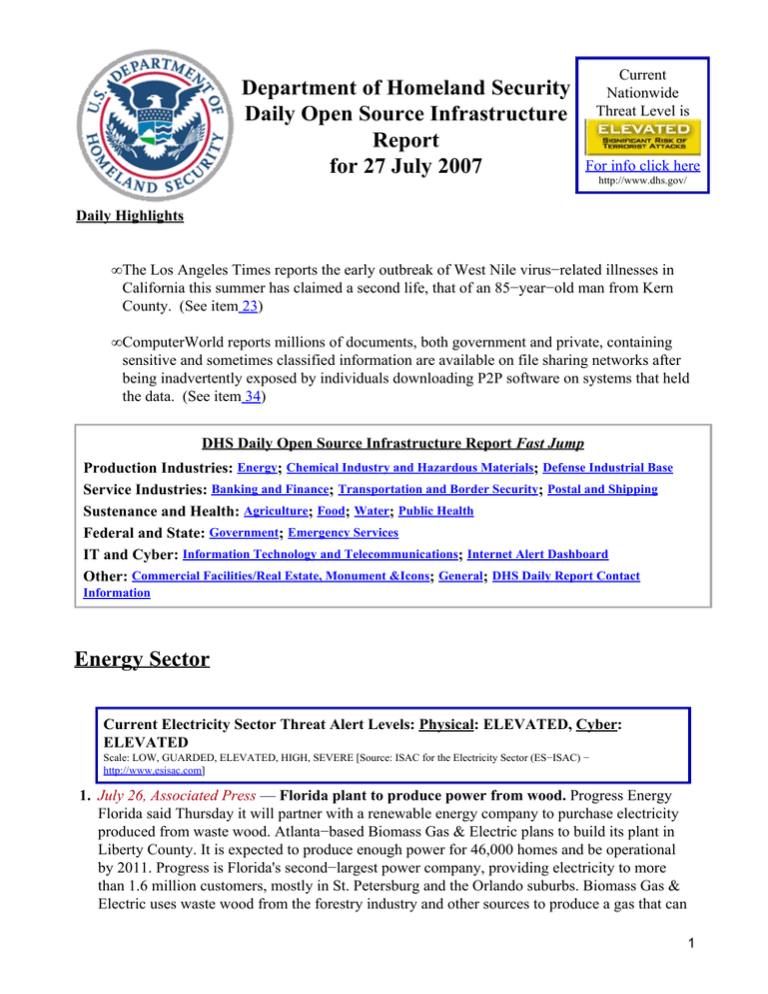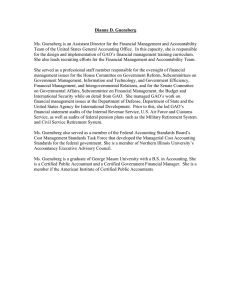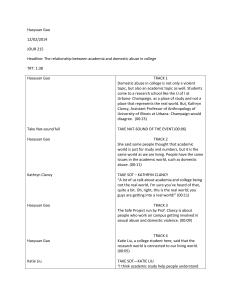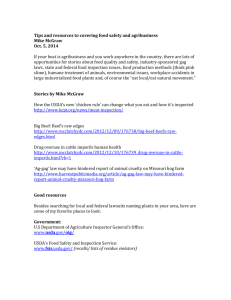Department of Homeland Security Daily Open Source Infrastructure Report for 27 July 2007
advertisement

Department of Homeland Security Daily Open Source Infrastructure Report for 27 July 2007 Current Nationwide Threat Level is For info click here http://www.dhs.gov/ Daily Highlights • The Los Angeles Times reports the early outbreak of West Nile virus−related illnesses in California this summer has claimed a second life, that of an 85−year−old man from Kern County. (See item 23) • ComputerWorld reports millions of documents, both government and private, containing sensitive and sometimes classified information are available on file sharing networks after being inadvertently exposed by individuals downloading P2P software on systems that held the data. (See item 34) DHS Daily Open Source Infrastructure Report Fast Jump Production Industries: Energy; Chemical Industry and Hazardous Materials; Defense Industrial Base Service Industries: Banking and Finance; Transportation and Border Security; Postal and Shipping Sustenance and Health: Agriculture; Food; Water; Public Health Federal and State: Government; Emergency Services IT and Cyber: Information Technology and Telecommunications; Internet Alert Dashboard Other: Commercial Facilities/Real Estate, Monument &Icons; General; DHS Daily Report Contact Information Energy Sector Current Electricity Sector Threat Alert Levels: Physical: ELEVATED, Cyber: ELEVATED Scale: LOW, GUARDED, ELEVATED, HIGH, SEVERE [Source: ISAC for the Electricity Sector (ES−ISAC) − http://www.esisac.com] 1. July 26, Associated Press — Florida plant to produce power from wood. Progress Energy Florida said Thursday it will partner with a renewable energy company to purchase electricity produced from waste wood. Atlanta−based Biomass Gas & Electric plans to build its plant in Liberty County. It is expected to produce enough power for 46,000 homes and be operational by 2011. Progress is Florida's second−largest power company, providing electricity to more than 1.6 million customers, mostly in St. Petersburg and the Orlando suburbs. Biomass Gas & Electric uses waste wood from the forestry industry and other sources to produce a gas that can 1 be used as a substitute for natural gas. The new source of energy won't raise the price of electricity for customers, said Progress Energy Florida President Jeff Lyash. The company is owned by Progress Energy of Raleigh, NC. Source: http://biz.yahoo.com/ap/070726/progress_renewable_energy.htm l?.v=2 2. July 26, Associated Press — U.S. natural gas in storage increases. Natural gas in storage in the U.S. grew last week and remains about 16 percent above the five−year average for this time of year, according to a government report Thursday, July 26. The Department of Energy’s Energy Information Administration said in its weekly report that natural gas inventories held in underground storage in the lower 48 states increased by 71 billion cubic feet to 2.763 trillion cubic feet for the week ending July 20, up from 2.692 trillion cubic feet for the previous week. The inventory level was well above the five−year average of 2.379 trillion cubic feet in underground storage, and slightly above last year's storage level of 2.757 trillion cubic feet, according to the government data. Source: http://biz.yahoo.com/ap/070726/natural_gas_storage.html?.v=1 3. July 25, Associated Content — Perry Nuclear Power Plant in Ohio re−opens after outage. According to the First Energy Nuclear Operating Company, Perry Nuclear Power Plant that is operated in North Perry, OH, has reopened after being shut down on June 29. The Perry Nuclear Power Plant was shut down in late June after routine testing revealed that one of the engines needed to be replaced. Once shut down, a 30−ton, 8,000−horsepower motor was installed in the area that controls the flow of water to the reactor vessel, known as the Reactor Recirculation System. Other routine and preventative maintenance work was also completed during the time of the shut down to ensure that the nuclear power plant is reliable and safe. Perry Nuclear Power Plant is owned and operated by First Energy Corporation. First Energy Corp. and it's subsidiaries comprise the nation's fifth largest investor owned electric system that serves over 1.5 million people in the New Jersey, Pennsylvania, and the Ohio areas. Source: http://www.associatedcontent.com/article/326349/perry_nuclea r_power_plant_in_ohio_reopens.html [Return to top] Chemical Industry and Hazardous Materials Sector 4. July 26, Hometownlife (MI) — Crew hits gas line at mall. Twelve Oaks Mall in Novi, MI, was evacuated Monday morning, July 23, after a construction crew hit a gas line outside the mall entrance, between Lord and Taylor and Sears. Even though the incident was quickly addressed, officials felt it necessary to evacuate the mall. The mall was reopened later that morning. Source: http://www.hometownlife.com/apps/pbcs.dll/article?AID=/20070 726/NEWS13/707260539/1030/rss09 [Return to top] Defense Industrial Base Sector Nothing to report. 2 [Return to top] Banking and Finance Sector 5. July 26, IDG News Service — DOJ charges former Safenet exec with stock backdating. Former Safenet Chief Financial Officer Carole Argo was charged Wednesday, July 25, with eight counts of securities fraud and conspiracy in connection with backdating millions of dollars worth of stock options, the U.S. Department of Justice (DOJ) said. U.S. Attorney for the Southern District of New York Michael J. Garcia filed the charges, alleging that between 2000 and 2006, Argo and co−conspirators, who were not named, systematically backdated stock option grants and conspired to conceal the practice from Safenet's board of directors and shareholders. By doing so, Argo and the others also would have caused the information security systems vendor to incorrectly report its revenue during that period. Source: http://www.infoworld.com/article/07/07/26/DOJ−charges−Safene t−exec_1.html 6. July 24, Department of the Treasury — Twin Treasury actions take aim at Hizballah’s support network. The U.S. Department of the Treasury on Tuesday, July 24, targeted Hizballah's support network by designating the Iran−based Martyrs Foundation, including its U.S. branch, and the finance firm Al−Qard al−Hassan under Executive Order 13224. Two individuals were also designated Tuesday for the role they play in Hizballah's support network. "We will continue to target those who form the financial backbone of Hizballah, Hamas, PIJ and other terrorist groups that are attempting to destabilize Lebanon and target innocent civilians," said Stuart Levey, Under Secretary for Terrorism and Financial Intelligence. "We will not allow organizations that support terrorism to raise money in the United States or to evade our measures and continue to operate simply by changing their names." The Martyrs Foundation is an Iranian parastatal organization that channels financial support from Iran to several terrorist organizations in the Levant, including Hizballah, Hamas, and the Palestinian Islamic Jihad (PIJ). Source: http://www.treasury.gov/press/releases/hp503.htm [Return to top] Transportation and Border Security Sector 7. July 26, CBS5/Associated Press — Hundreds evacuated from Long Beach Airport. A suspicious item in a piece of luggage prompted the evacuation of several hundred people from the Long Beach Airport terminal Thursday, July 26, and delayed inbound flights, authorities said. The item was discovered in a checked bag by federal Transportation Security Administration workers at about 9:30 a.m. PDT, agency spokesperson Jennifer Peppin said. Firefighters, police, and a Los Angeles County sheriff’s bomb squad were called to the airport, about 25 miles south of downtown Los Angeles. Inbound flights were landing but were held out on the tarmac. Outbound flights were delayed or cancelled, airport spokesperson Maricela de Rivera said. Source: http://cbs5.com/business/local_story_207131805.html 8. 3 July 26, Government Accountability Office — GAO−07−920: Surface Transportation: Strategies Are Available for Making Existing Road Infrastructure Perform Better (Report). For the past several decades, the capacity of the nation’s road network has not grown fast enough to keep pace with demand. The increasing congestion is apparent to millions of commuters and freight operators. Although road building is perhaps the most familiar antidote, Congress, the Department of Transportation (DOT), and transportation research have emphasized the need to more efficiently use the existing infrastructure as a means to control congestion. The Government Accountability Office (GAO) was asked to examine various issues associated with increasing the efficient use of existing infrastructure. This report examines the following questions: (1) What factors inhibit the efficient use of the existing infrastructure of roads and highways? (2) What techniques have been developed for making the current infrastructure more efficient and what is known about the results? (3) How have local decision makers implemented these techniques? (4) What strategies exist for increasing the use of such techniques? To address these questions, GAO reviewed existing studies, examined efforts in five states, and sought transportation officials’ views, among other things. GAO is not making recommendations in this report. In commenting on a draft of this report, DOT provided technical clarifications, which we incorporated as appropriate. Highlights: http://www.gao.gov/highlights/d07920high.pdf Source: http://www.gao.gov/cgi−bin/getrpt?GAO−07−920 9. July 26, Government Accountability Office — GAO−07−772: Highway and Transit Investments: Flexible Funding Supports State and Local Transportation Priorities and Multimodal Planning (Report). The Intermodal Surface Transportation Efficiency Act of 1991 introduced two highway programs—the Surface Transportation Program (STP) and the Congestion Mitigation and Air Quality Program (CMAQ)—that may be used on both highway and transit projects and that are referred to as “flexible funding” for the purposes of this report. GAO was asked to examine (1) the degree to which STP and CMAQ funding has been used on transit and how this use varies across states and urbanized areas, and (2) how states and urbanized areas decide which projects to fund with STP and CMAQ funding and what the outcomes of these decisions have been. To address these issues, the Government Accountability Office (GAO) analyzed data on flexible funding used on transit projects from the Federal Transit Administration and the Federal Highway Administration and spoke with officials in selected states and urbanized areas about their project−selection processes for flexible funding and the outcomes of these funding decisions. States and urbanized areas were selected based on their prior use of flexible funding. GAO is not making recommendations in this report. The Department of Transportation generally agreed with the report’s findings and provided technical clarifications, which were incorporated in the report as appropriate. Highlights: http://www.gao.gov/highlights/d07772high.pdf Source: http://www.gao.gov/cgi−bin/getrpt?GAO−07−772 10. July 25, Associated Press — Threat forces plane to return to Seattle. A man who had missed his flight said there was a bomb aboard the plane Wednesday, July 25, forcing it to return to Seattle−Tacoma International Airport even though authorities did not believe the threat was legitimate, an airport spokesperson said. "The plane was brought back, erring on the side of caution, after he made that threatening statement," Transportation Security Administration spokesperson Jennifer Peppin said. Airport police were questioning a man who told a gate agent there was a bomb on Northwest Airlines Flight 980 shortly after the plane left Seattle for 4 Memphis around 12:33 p.m. PDT, airport spokesperson Terri−Ann Betancourt said. The man was never on the plane and had no luggage on the aircraft, Betancourt said. She said the man's motive was unclear, but "it was clear he wanted the plane to come back." The plane, which had 142 passengers, returned to the airport around 1:15 or 1:20 p.m., Betancourt said. Source: http://www.washingtonpost.com/wp−dyn/content/article/2007/07 /25/AR2007072501729.html [Return to top] Postal and Shipping Sector 11. July 26, Government Accountability Office — GAO−07−1083T: U.S. Postal Service: Progress Made in Implementing Mail Processing Realignment Efforts, but Better Integration and Performance Measurement Still Needed (Testimony). GAO reported in 2005 on major changes in the mailing industry that have reinforced the need for the U.S. Postal Service (USPS) to reduce costs and increase efficiency. To address these changes and become more efficient, USPS is implementing initiatives aimed at realigning its mail processing network. In a follow−up review, the Government Accountability Office (GAO) recently reported that USPS has made progress in implementing these initiatives, yet challenges such as maintaining delivery standards and addressing stakeholder and community resistance remain. In July 2006, GAO also reported on USPS’s progress in improving delivery performance information. This testimony describes (1) the changes that have affected USPS’s processing network, (2) GAO’s concerns related to USPS’s strategy for realigning its mail processing network and implementing its area mail processing consolidations, and (3) GAO’s concerns related to USPS’s progress in improving delivery performance information. This testimony is based on prior GAO reports. GAO made recommendations to USPS to enhance the planning, accountability, and public communications related to its realignment efforts and to improve its delivery performance measures. USPS’s response to the statutory requirements enacted in December 2006 is an opportunity to address GAO’s recommendations. Source: http://www.gao.gov/cgi−bin/getrpt?GAO−07−1083T 12. July 21, Government Accountability Office — GAO−07−717: U.S. Postal Service: Mail Processing Realignment Efforts Under Way Need Better Integration and Explanation (Report). Major changes in the mailing industry have reinforced the need for the U.S. Postal Service (USPS) to reduce costs and increase efficiency. In its 2002 Transformation Plan, USPS proposed doing so by realigning its mail processing network. The objectives of this requested report are to (1) describe the status of the initiatives USPS has developed for realignment; (2) evaluate how the planning, impacts, and results of these initiatives align with realignment goals; and (3) evaluate USPS’s communication practices with stakeholders in making realignment decisions. To strengthen planning and accountability for USPS’s realignment efforts, the Postmaster General should ensure that the Facilities Plan, required by the Postal Accountability and Enhancement, explains the integration of realignment initiatives and establishes measurable targets to track USPS’s progress in meeting realignment goals. To help improve communication about realignment with stakeholders, the Postmaster General should modify USPS’s communication strategy to improve the quality of public notices and engagement, and increase transparency in decision making. In response to the Government Accountability Office’s (GAO) draft report, USPS agreed with GAO’s findings and recommendations and plans to take 5 steps to improve its communication and transparency. Highlights: http://www.gao.gov/highlights/d07717high.pdf Source: http://www.gao.gov/cgi−bin/getrpt?GAO−07−717 [Return to top] Agriculture Sector 13. July 26, South Dakota Ag Connection — Cattle death toll exceeds 1,100 during heat wave. Slightly cooler weather late in the week should reduce chances for more cattle deaths like the more than 1,000 that producers reported July 23 through July 25, state veterinarian Sam Holland said. As many as 1,100 cattle, most of them being finished for sale in feedlots, died in the high heat and humidity. It's a rare occurrence that caught many off guard. "I don't remember that kind of loss in our state in recent years," Holland said. "It's a disaster for some people." Source: http://www.southdakotaagconnection.com/story−state.php?Id=55 6&yr=2007 14. July 25, Agricultural Research Service — Plum−pox−resistant trees move forward. Plum trees with resistance to plum pox (PPV), a virus that can devastate stone fruit, have moved a step closer to reality, according to the Agricultural Research Service (ARS). The U.S. Department of Agriculture's Animal and Plant Health Inspection Service (APHIS), which has regulatory authority over genetically engineered organisms, recently "deregulated" HoneySweet, as the PPV−resistant plum tree is named. This means APHIS had determined that the tree is not a plant pest and that it will have no significant impact on other plants. ARS is now taking the next step in HoneySweet's development, which is for cooperators such as universities to plant small quantities of the trees to study how they grow under a variety of conditions. A standard genetic engineering technique was used to introduce a gene for the PPV coat protein into cells extracted from plum seeds. Cells that incorporated the new gene into the plum DNA were then regenerated and grown into complete plum trees. These trees have the new gene in their DNA and are resistant to PPV through a process called gene silencing. While HoneySweet itself produces fruit of commercial standard, it may also be used as breeding stock to introduce PPV resistance into other plum breeding lines. Source: http://www.ars.usda.gov/is/pr/2007/070725.htm 15. July 25, Associated Press — Ministry says China trying to combat rampant pig disease. Nearly 90,000 pigs have died or been slaughtered because of blue ear disease, a Chinese Ministry of Agriculture official said Wednesday, July 25. The epidemic has now spread to 25 provinces or regions, said Li Jinxiang, a veterinarian with the ministry. Li told a news conference that by the start of this week, 165,144 pigs had contracted the disease. So 45,546 had died and another 42,728 had been slaughtered. Li said the ministry had developed a vaccine for the epidemic and would start delivering it next month. Many farmers have stopped raising pigs for fear they might be stricken by the disease, authorities say. Source: http://www.iht.com/articles/ap/2007/07/25/asia/AS−GEN−China− Pig−Disease.php 16. July 25, Minnesota Ag Connection — Researchers using Chinese import to battle soybean aphids. University of Minnesota scientists are field testing a beneficial insect, a stingless wasp from China also known as Binodoxys communis, that kills soybean aphids. A successful field 6 test would be a major breakthrough in controlling a damaging crop pest. The soybean aphid first appeared in Minnesota fields in 2000 and costs soybean growers an estimated $200 million annually in lost crop yields and spraying costs in Minnesota alone. The national cost is much higher. "The soybean aphid was imported without any of its natural enemies, the organisms that keeps aphids in check in China," said Dave Ragsdale, U of M entomologist. "Our researchers and Extension experts are working to provide that check and balance system." Binodoxys communis was approved for release based upon four years of laboratory safety testing. It is an especially promising species for control of soybean aphid, because it comes from a region in China that is a good climate match to Minnesota. Source: http://www.minnesotaagconnection.com/story−state.php?Id=685& yr=2007 [Return to top] Food Sector 17. July 25, Food Safety and Inspection Service — Ground beef and buffalo products recalled. Custom Pack, Inc., a Hastings, NE, establishment, is voluntarily recalling approximately 5,920 pounds of ground beef and buffalo products because they may be contaminated with E. coli O157:H7, the U.S. Department of Agriculture’s Food Safety and Inspection Service (FSIS) announced Wednesday, July 25. The ground beef products were produced between June 1 and June 13, 2007, and were distributed to restaurants and institutions in Nebraska. The ground buffalo patties were produced on June 7, 2007, and distributed to restaurants and institutions in Colorado. None of these products were sold through grocery stores. The problem was discovered through sampling done by the Nebraska Department of Health Services, in coordination with the U.S. Centers for Disease Control and Prevention, as part of an investigation into a reported illness. E. coli O157:H7 is a potentially deadly bacterium that can cause bloody diarrhea and dehydration. The very young, seniors and persons with compromised immune systems are the most susceptible to foodborne illness. Source: http://www.fsis.usda.gov/News_&_Events/Recall_035_2007_Relea se/index.asp 18. July 25, Agence France−Presse — China passes draft law on food safety. China on Wednesday, July 25, passed a draft law that demands strengthened quality standards and supervision of food amid the recent spate of safety scandals surrounding Chinese products. The draft stated it would "strictly regulate producers, strengthen the monitoring and responsibility of local governments and also increase the punishment for violations." International alarm over Chinese food exports has been building for months amid reports of toxic products endangering lives in the U.S. and other countries. Source: http://news.yahoo.com/s/afp/20070725/hl_afp/healthchinafoods afety_070725175155;_ylt=AjE1Y1.c.jvy8D8FyZtkuFGJOrgF 19. July 25, Reuters — China to tighten control of antibiotics in seafood. China will step up inspections on the use of antibiotics in fish farms, including chemicals that can cause cancer, after contaminants caused trading partners to block its seafood exports. "We are focusing on getting a hold on antibiotic use, especially overuse of antibiotics on fish and crustaceans, including nitrofurans and malachite green," Zhang Yuxiang, director of the market and economic information department of the Ministry of Agriculture, told a news conference on Wednesday, July 25. The ministry said last month that malachite green, a cancer−causing 7 chemical used by fish farmers to kill parasites, had been found in some food samples, as well as nitrofurans, an antibiotic also linked to cancer. China is the largest producer of farmed fish, handling 50 percent of the total value of global aquacultured seafood exports around the world. It is the third−largest exporter of seafood to the U.S. Last month, the U.S. Food and Drug Administration said a sampling of imported Chinese seafood from October 2006 through May 2007 found more than 15 percent of shipments were contaminated with antimicrobial agents that are not approved for use in farm−raised seafood in the U.S. Source: http://www.reuters.com/article/healthNews/idUSPEK24113920070 725 [Return to top] Water Sector 20. July 25, Miami Herald — Water finally flows back into Okeechobee. After 252 days, water is flowing south from the Kissimmee River into Lake Okeechobee. The amount isn't much, but it's still a milestone after an 18−month drought that has put much of South Florida on severe water restrictions. The lake, at 9.11 feet above sea level on Wednesday, Ju;y 25, remains nearly four feet below normal for this time of year and has barely budged since hitting a record low of 8.82 feet on July 3. Finally, after some eight−plus inches of rain in the last month −− nearly three to four inches above normal −− the parched drainage basins lining the Kissimmee River and its chain of large lakes filled up enough to trigger flow to the south. The 730−square−mile lake, a critical reservoir for South Florida, typically gets about half its water from the Kissimmee River and other tributaries to the north. Water managers consider restored river flows critical to raising the lake and ending the shortage. Without that flow, most of the rain that falls over the lake is lost to evaporation. Source: http://www.miamiherald.com/416/story/181861.html 21. July 24, Charlotte News & Observer (NC) — Cary has water mix−up. The bitter water pouring from Vinay Jain's tap was a water conservation measure gone foul. For nearly five months, the Jain family home in Cary, NC, has been connected to the town's reclaimed−water system. That is the treated wastewater the town considers clean enough for suburban lawns but not good enough to drink. Jain lived with the funny−tasting water until Monday, July 23. Then, suddenly, the water in the house went off. Somebody had shut off the neighborhood's irrigation pipe. Cary water workers discovered the goof after Jain's neighbors, who had water inside, realized that their sprinklers weren't spraying. Cary officials say the risk from reclaimed water is low. By one estimate, you would have to drink 12 gallons of reclaimed water in a single sitting to get an infectious dose of coliform bacteria. But it is serious: State regulations ban water systems from distributing reclaimed water for consumption. Currently, water workers think somebody switched the Jains' black drinking−water main and their purple reclaimed−water main between their water main installation and their final home inspection. Source: http://www.newsobserver.com/news/story/648585.html [Return to top] Public Health Sector 8 22. July 26, Reuters — Unknown illness hits Indonesian village, eight dead. Indonesian doctors are investigating the outbreak of an unknown illness that has killed eight people and infected 22 in a Java village, a health ministry official said on Thursday, July 26. "This is not SARS or bird flu, but it is certainly as worrying," Marwan Nusri of the Disease Control and Environmental Health Department told Reuters. "At first we suspected poisoning, but after checking their food and water we didn't find any toxic substance." Nusri said around 30 people in the remote Kanigoro village, in Central Java province, had been hospitalized in the past three days with similar symptoms such as severe nausea and seizures. Nusri added the health ministry was looking at the possibility of a virus or bacteria that targets a specific internal organ, but declined to give details. Source: http://www.reuters.com/article/healthNews/idUSJAK24003120070 726 23. July 25, Los Angeles Times — West Nile claims second victim. The early outbreak of West Nile virus−related illnesses in California this summer has claimed a second life, that of an 85−year−old man from Kern County, officials said Tuesday, July 25. Officials with the California Department of Public Health said 36 people in the state had been reported to have West Nile−related illnesses this year, compared with 16 cases by this time in 2006. Most of this year's cases, 28, have come in Kern County. All of the others also have been in Central or Northern California, with the exception of one illness in Imperial County. The first Californian to die this year of a West Nile−related illness, an elderly woman, was also from Kern County. Source: http://www.latimes.com/news/printedition/california/la−me−we stnile25jul25,1,828219.story?coll=la−headlines−pe−california 24. July 25, Agence France−Presse — India reports bird flu outbreak in northeast. India's government has reported an outbreak of bird flu among poultry, the first outbreak since it declared itself free of the disease last August. The government's department of animal husbandry said it had started to cull tens of thousands of birds in the northeastern state of Manipur, where 132 of 144 chickens at a small poultry farm died earlier this month. The health ministry said it had rushed 'rapid response teams' to test 450,000 people for possible symptoms of bird flu. Source: http://www.forbes.com/markets/feeds/afx/2007/07/25/afx395040 8.html 25. July 24, KKTV (CO) — Plague found in El Paso County prairie dogs. The El Paso, CO, Health Department has confirmed several prairie dog sites are infected with plague. The sites are at Schriever Air Force Base and on neighboring property, in eastern El Paso County. Plague is commonly found in the Western U.S. in small ground animals that have been bitten by fleas. Human cases aren't not common, but plague can be transmitted to people from infected animals. Since 1941, there have bee 55 cases in Colorado of human plague. Source: http://www.kktv.com/news/headlines/8684382.html [Return to top] Government Sector 26. July 26, Government Computer News — CRS critical of fusion center IT in audit of state command centers. State intelligence fusion centers, which have received praise along with 9 federal funds as a tool for merging terrorism, law enforcement, and all−hazard intelligence, are struggling to produce useful information as a result of tangled technology and unclear missions, according to a nationwide study. The report, entitled “Fusion Centers: Issues and Options for Congress” and completed this month by the Congressional Research Service, cited problems with the centers’ lack of connectivity with existing law enforcement databases and poor compliance with federally backed technical data−sharing standards. Federal agencies have contributed to the problems by spewing overlapping data at the centers via uncoordinated and insecure networks that are hard to use, the auditors said. The state officials reportedly said that different federal agencies require divergent technologies to protect the workstations that handle their classified information. The lack of reciprocity and coordination among federal agencies in the area of technical requirements for secure facilities forces costs upward, according to state officials cited in the CRS report. The federal government plans to reduce that plethora of classification categories to three under a project known as the Controlled Unclassified Initiative, but those changes have not received final approval, the report said. Source: http://www.gcn.com/online/vol1_no1/44733−1.html [Return to top] Emergency Services Sector 27. July 25, Government Accountability Office — GAO−07−1124T: Small Business Administration: Response to the Gulf Coast Hurricanes Highlights Need for Enhanced Disaster Preparedness (Testimony). The Small Business Administration (SBA) helps individuals and businesses recover from disasters such as hurricanes through its Disaster Loan Program. SBA faced an unprecedented demand for disaster loan assistance following the 2005 Gulf Coast hurricanes (Katrina, Rita, and Wilma), which resulted in extensive property damage and loss of life. In the aftermath of these disasters, concerns were expressed regarding the timeliness of SBA's disaster assistance. The Government Accountability Office (GAO) initiated work and completed two reports under the Comptroller General's authority to conduct evaluations and determine how well SBA provided victims of the Gulf Coast hurricanes with timely assistance. This testimony, which is based on these two reports, discusses (1) challenges SBA experienced in providing victims of the Gulf Coast hurricanes with timely assistance, (2) factors that contributed to these challenges, and (3) steps SBA has taken since the Gulf Coast hurricanes to enhance its disaster preparedness. GAO visited the Gulf Coast region, reviewed SBA planning documents, and interviewed SBA officials. GAO recommends that SBA take several steps to improve its disaster preparedness, and SBA agreed with these recommendations. Highlights: http://www.gao.gov/highlights/d071124thigh.pdf Source: http://www.gao.gov/cgi−bin/getrpt?GAO−07−1124T 28. July 25, Courier−Journal (KY) — Hospital links disaster efforts through new software. With a couple of mouse clicks, Stephan French, the vice president of facilities development at Jewish Hospital Medical Center South in Bullitt County, KY, could disable the airflow system at the hospital to prevent toxic air from entering. While French, who was participating in a disaster demonstration on Tuesday, July 24, didn't actually disable the system, he could do so within seconds during a real emergency from the downtown Louisville campus of Jewish Hospital & St. Mary's HealthCare. Jewish held a demonstration at its downtown campus on 10 Tuesday to show how the software would work during a disaster. An incident command team of five people spent about two hours responding to scenarios that have happened. First, a tornado hit Pioneer Village in Bullitt County, then a train derailment caused a fire and chemical spill. Throughout the drill, the software allowed French to access timely information his team could use in responding to the disaster, such as preparing for victims or deciding if the hospital had to be evacuated. Source: http://www.courier−journal.com/apps/pbcs.dll/article?AID=/20 070725/NEWS01/707251185 [Return to top] Information Technology and Telecommunications Sector 29. July 25, IDG News Service — Mozilla flaw attack code published. Mozilla is working on patching its Firefox browser after a hacker posted details of a flaw that could let criminals run unauthorized software on a victim's machine. The flaw lies in Firefox's URL handler component, which was the source of another bug Mozilla disclosed Tuesday, July 24. This second flaw was disclosed Tuesday by Billy Rios and Nathan McFeters, security consultants with Verisign and Ernst & Young respectively. Like the first flaw, this one could be exploited by attackers to launch programs on the victim's PC without authorization, said Tyler Reguly, a security research engineer at nCircle Network Security. "They're both related to the URL handling process," he said "It's just different errors within that handling process." Even though the code posted by Rios and McFeters can only be used to launch software that is already installed on a victim's PC, it could be very dangerous if used by criminals, Reguly said. "It's still letting you run any program that exists on the user's computer," he said. "You can make it do some fairly bad things. For example, having it use command−line FTP to download a malicious file off a server somewhere and then execute that file." Rios' blog: http://xs−sniper.com/blog/2007/07/24/remote−command−executio n−in−firefox−2005/ Source: http://www.infoworld.com/article/07/07/25/Researcher−publish es−attack−code−for−Mozilla−flaw_1.html 30. July 25, ComputerWorld — Largest vendors account for fewer software flaws. Though it might not seem that way, the top 10 most vulnerable software vendors −− and, yes, that includes Microsoft Corp. −− are contributing a smaller percentage of all vulnerability disclosures per year compared to five years ago. That's according to an analysis by Gunter Ollmann, director of security strategies at IBM's Internet Security Systems X−Force team. Ollmann, who crunched vulnerability data gathered by X−Force between 2002 and 2006, said the overall percentage of security flaws disclosed by the most vulnerable software vendors dropped from 20.2 percent in 2002 to 14.6 percent during that period. Much of that decrease is likely the result of improved quality assurance and testing processes by the most vulnerable software vendors, Ollmann said. Most of their software packages have been through multiple versions and have been combed thoroughly for vulnerabilities by security researchers, Ollmann said. As larger vendors begin to do a better job of locking down their software, hackers and software researchers have begun focusing their attention on newer vendors and their applications, which has resulted in an overall increase in the number of vulnerabilities being reported, Ollmann said. 11 Source: http://www.computerworld.com/action/article.do?command=viewA rticleBasic&articleId=9027947&source=rss_topic85 31. July 25, VNUNet — Password flaw hits Firefox and Safari. The latest versions of Firefox and Safari contain a password management security flaw that could allow certain Websites to access stored usernames and passwords. A message on the Full Disclosure mailing list warned that users who have either browser configured to remember passwords, and have JavaScript enabled, are at risk. Mozilla fixed a similar reverse cross−site scripting flaw in Firefox last November, but this was a lot more serious as it did not require JavaScript to be enabled. Heise Security has a demonstration of the vulnerability on its Website to allow users to determine whether they are vulnerable to the attack. However, some developers and commentators have questioned whether this constitutes a vulnerability in the browser, as it requires the attacker to place malicious code on the Web server. Heise Security demonstration: http://www.heise−security.co.uk/services/browsercheck/demos/ moz/pass1.shtml Source: http://www.vnunet.com/vnunet/news/2194933/firefox−safari−pas sword−flaw 32. July 24, Sydney Morning Herald (Australia) — Mobile phone spammer fined in Australia. A mobile phone marketing company has been fined almost $132,000 over spamming practices that affected thousands of people over the past 12 months. DC Marketing Europe, a company notorious for its "missed call" telemarketing schemes, has been fined by the Australian Communications and Media Authority for breaching the Spam Act in July and August last year, by sending unsolicited messages that failed to identify the sender and did not allow the recipient to unsubscribe. Authorities say they are handling as many as 1800 complaints a month from mobile phone customers over rip−offs. Hidden charges and the inability to cancel subscriptions to services such as ringtones, wallpaper and video clips were the most common complaints among the 9000 recorded by the Telecommunications Industry Ombudsman over the past six months, under the Mobile Premium Services Industry Scheme. In the previous 12 months the ombudsman handled fewer than 6000 complaints over premium services, which suggests that complaints have risen threefold since the scheme began. Source: http://www.smh.com.au/news/security/mobile−phone−spammer−fin ed−150000/2007/07/23/1185043066651.html Internet Alert Dashboard To report cyber infrastructure incidents or to request information, please contact US−CERT at soc@us−cert.gov or visit their Website: www.us−cert.gov. Information on IT information sharing and analysis can be found at the IT ISAC (Information Sharing and Analysis Center) Website: https://www.it−isac.org/. [Return to top] Commercial Facilities/Real Estate, Monument &Icons Sector 33. July 25, KGW (OR) — Troutdale pipe bomb explosion launches shrapnel 200 feet. Shrapnel punctured several homes when a pipe bomb exploded in Troutdale, OR, and shaken residents 12 want to know who was behind the attack. Several neighbors called 911 after hearing or seeing the explosion Monday, July 23. "If there was someone outside, it would have definitely injured someone, if not worse," said Sgt. Steve Bevens with the Troutdale Police Department. Investigators said shrapnel from the blast flew as far as 200 feet and punctured several homes and a backyard pool. There were no reports of serious injuries. Source: http://www.kgw.com/news−local/stories/kgw_072507_news_pipe_b omb_troutdale.ad38876f.html [Return to top] General Sector 34. July 25, ComputerWorld — Classified U.S. military info, corporate data available over P2P. Millions of documents, both government and private, containing sensitive and sometimes classified information are floating about freely on file sharing networks after being inadvertently exposed by individuals downloading P2P software on systems that held the data, members of a House committee were told Tuesday, July 24. Among the documents exposed: The Pentagon's entire secret backbone network infrastructure diagram, complete with IP addresses and password change scripts; contractor data on radio frequency manipulation to beat Improvised Explosive Devices in Iraq; physical terrorism threat assessments for three major U.S. cities; information on five separate Department of Defense information security system audits. Information about the breach came during a hearing on inadvertent file sharing over peer−to−peer (P2P) networks held by the House Committee on Oversight and Government Reform. One of those testifying was retired General Wesley Clark, who is currently a board member of Tiversa Inc. Clark described how "in a matter of hours" he was able to lay hands on over 200 documents containing classified and secret government data from P2P networks using Tiversa's search engine. The data included everything from Iraq status reports to a list of soldiers with their Social Security numbers. Source: http://www.computerworld.com/action/article.do?command=viewA rticleBasic&articleId=9027949&intsrc=hm_list [Return to top] DHS Daily Open Source Infrastructure Report Contact Information DHS Daily Open Source Infrastructure Reports − The DHS Daily Open Source Infrastructure Report is a daily [Monday through Friday] summary of open−source published information concerning significant critical infrastructure issues. The DHS Daily Open Source Infrastructure Report is archived for ten days on the Department of Homeland Security Website: http://www.dhs.gov/iaipdailyreport DHS Daily Open Source Infrastructure Report Contact Information Content and Suggestions: Send mail to dhsdailyadmin@mail.dhs.osis.gov or contact the DHS Daily Report Team at (703) 983−3644. 13 Subscription and Distribution Information: Send mail to dhsdailyadmin@mail.dhs.osis.gov or contact the DHS Daily Report Team at (703) 983−3644 for more information. Contact DHS To report physical infrastructure incidents or to request information, please contact the National Infrastructure Coordinating Center at nicc@dhs.gov or (202) 282−9201. To report cyber infrastructure incidents or to request information, please contact US−CERT at soc@us−cert.gov or visit their Web page at www.us−cert.gov. Department of Homeland Security Disclaimer The DHS Daily Open Source Infrastructure Report is a non−commercial publication intended to educate and inform personnel engaged in infrastructure protection. Further reproduction or redistribution is subject to original copyright restrictions. DHS provides no warranty of ownership of the copyright, or accuracy with respect to the original source material. 14








